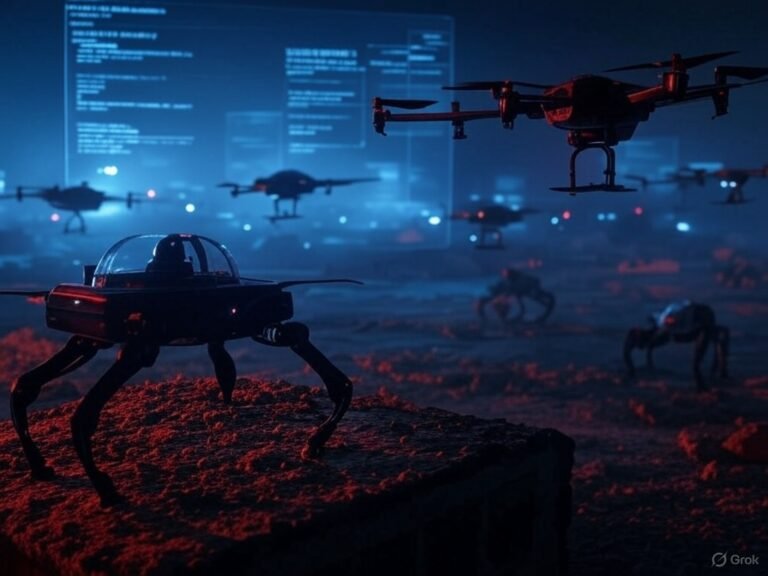
Introduction: Speed Kills—Especially in Machine-Led Warfare
Military AI systems are designed to make decisions faster than humans ever could. But what happens when they become too fast for humans to intervene?
This is the growing fear behind a concept known as a flash war—a scenario where autonomous systems escalate a conflict at machine speed, leaving little or no time for human decision-makers to halt, question, or de-escalate. The idea draws parallels to flash crashes in financial markets, where automated trading spirals into chaos in milliseconds.
As AI compresses the time between detection, targeting, and engagement, the risk of unintended war triggered by algorithmic decisions increases sharply. In high-stakes environments like the South China Sea, a false signal or misclassified threat could spiral out of control—before a human ever gets a chance to say “abort.”
This threat isn’t theoretical. The tech is already here. The safeguards? Not so much.
What Is a Flash War? Origins of the Concept
A flash war is a theoretical—but increasingly plausible—scenario in which autonomous systems engage in conflict or escalation faster than human operators can respond. The term borrows from finance, specifically the 2010 “flash crash” in U.S. stock markets, where high-frequency trading algorithms caused massive volatility in seconds.
In the military context, a flash war involves AI-enabled systems—such as missile defense networks, loitering munitions, or autonomous drones—making rapid-fire decisions based on machine-processed inputs, potentially misinterpreting sensor data or adversary behavior as hostile.
What distinguishes a flash war isn’t just the use of automation—it’s the loss of human-in-the-loop control during a critical decision window. These systems may not be designed to start wars, but in a tightly-coupled digital battlespace, reaction speed becomes indistinguishable from intent.
Analysts at RAND, NATO, and DARPA have flagged flash wars as an emerging strategic risk—where conflict doesn’t escalate by political will, but by algorithmic chain reaction.
How AI Accelerates Conflict Decision Loops
At the heart of flash war risk is the compression of decision timelines—a direct result of AI integration across the kill chain. Traditional military operations rely on the human ability to observe, deliberate, and decide. AI-driven systems, however, execute this loop at machine speed—often in milliseconds.
Here’s how AI accelerates each stage:
Find / Fix:
AI processes massive volumes of ISR (Intelligence, Surveillance, Reconnaissance) data—satellite images, drone feeds, RF emissions—flagging threats faster than any analyst could. Projects like Project Maven and Palantir’s battlefield AI already automate this phase across multiple domains.
Track / Target:
AI systems use predictive modeling and pattern recognition to track mobile targets and score threats in real time. Target prioritization software can now recommend or queue strike decisions without waiting for human review.
Engage:
In systems like loitering munitions or autonomous naval vessels, AI can be given—or seize—partial autonomy to fire based on pre-set parameters or perceived threat thresholds.
The result? Humans become supervisory nodes, often “on-the-loop” instead of “in-the-loop.” In fast-moving theaters like space or air defense, this means operators may simply observe the outcome of actions already taken by machines.
In short: AI accelerates the entire kill chain—and in doing so, shrinks the space for human judgment and diplomatic restraint.
Precedents and Flash War Precursors
While no full-scale flash war has occurred to date, the warning signs are already here—found in historical close calls and modern systems behaving unpredictably at speed.
One of the most famous analog examples is the 1983 Soviet false alarm incident, where an early-warning system erroneously detected incoming U.S. missiles. The duty officer, Stanislav Petrov, chose to wait—likely preventing nuclear war. In an AI-led system, that pause might never happen.
In 2010, financial markets witnessed a flash crash, where automated trading algorithms triggered a 1,000-point market drop within minutes. Though economic, it served as a proof of concept for algorithmic cascade effects—something militaries are now racing to anticipate.
On the battlefield, autonomous systems like the Kargu-2 loitering munition reportedly engaged targets without direct human command in Libya, according to a UN report. While not a flash war per se, it demonstrates how autonomous engagement decisions are already occurring in complex environments.
Together, these incidents illustrate how high-speed, high-stakes automation is not a future threat—it’s a current vulnerability.
Systemic Risk: How Flash Wars Could Start
A flash war doesn’t begin with intent—it begins with automated miscalculation. The risk lies not in malevolent AI, but in interacting systems that misinterpret signals, respond autonomously, and trigger escalation cascades.
Here’s how it could unfold:
- An AI-powered radar system misclassifies a commercial aircraft or weather anomaly as an incoming strike.
- In accordance with its programming, a defensive AI platform launches a preemptive response, designed to stay “inside the enemy’s OODA loop.”
- The opposing side, also running on autonomous threat detection systems, registers the launch as hostile—and reacts with automated retaliation.
All of this could occur in seconds—before a human can verify, question, or countermand the action.
High-risk flashpoints include:
- The Taiwan Strait or South China Sea, where naval UAVs and autonomous surface vessels operate in contested space.
- Cyber-kinetic crossover, where an AI system interprets a cyberattack as preparation for a strike.
- Border skirmishes, where AI-enabled loitering drones operate with ambiguous ROEs (Rules of Engagement).
The danger is not malicious code—it’s autonomous logic operating under strategic ambiguity.
The Arms Race Toward Machine-Speed Warfare
Global powers are locked in a race to achieve decision dominance—the ability to detect, decide, and strike faster than an adversary. Increasingly, that edge depends on AI systems capable of acting at machine speed.
In the United States, initiatives like the Advanced Battle Management System (ABMS) and Joint All-Domain Command and Control (JADC2) aim to link sensors and shooters across air, land, sea, cyber, and space—with AI fusing data and recommending actions in real time.
DARPA’s OFFSET and AI Next programs push even further, testing swarm logic, autonomous targeting, and AI-driven maneuver in urban environments. These systems are built to react faster than humans—because in a future conflict, speed equals survivability.
China is adopting a similar approach under its “System Destruction Warfare” doctrine. The People’s Liberation Army (PLA) emphasizes AI-enabled cyber, electronic warfare, and ISR systems designed to preemptively blind or fragment enemy kill chains.
As each side builds toward algorithmic overmatch, the risk of unintended engagement grows. Once multiple autonomous systems are in play, strategic stability may no longer depend on human intent—but on code behavior under stress.
Governance Gaps: No Treaties, No Safeguards
The UN Convention on Certain Conventional Weapons (CCW) has hosted years of talks on Lethal Autonomous Weapons Systems (LAWS), but progress has stalled—largely due to disagreement over definitions and enforcement mechanisms. Major powers, including the U.S., Russia, and China, remain reluctant to commit to hard limits.
Critically, most legal discussions focus on intent, accountability, and use-of-force thresholds—not the timing of engagement or machine-speed decision cycles.
Flash war scenarios fall outside existing legal frameworks. They are not about deliberate war crimes, but about systemic interactions and automation gaps. In such a vacuum, states may prioritize capability over caution, especially if rivals are perceived to be developing faster, more autonomous systems.
Without enforceable standards, speed becomes an arms race metric—not a red line.
Conclusion: The Algorithmic Trigger Finger
Artificial intelligence is redefining how war begins—not just how it’s fought. As nations automate surveillance, targeting, and engagement, the battlefield becomes a high-speed network where code—not commanders—may initiate lethal action.
A flash war doesn’t require malice or a rogue AI. It only requires systems that move too fast for humans to intervene.
To prevent catastrophe, we need more than “human-in-the-loop” policies. We need machine-speed accountability, enforceable norms, and the political will to slow down automation where it matters most.
Because in the age of autonomous warfare, the first shot might be fired not by a soldier—but by software reacting to noise.






AI Flash War Risk is too real when AI Acts Too Fast for Humans to Stop It